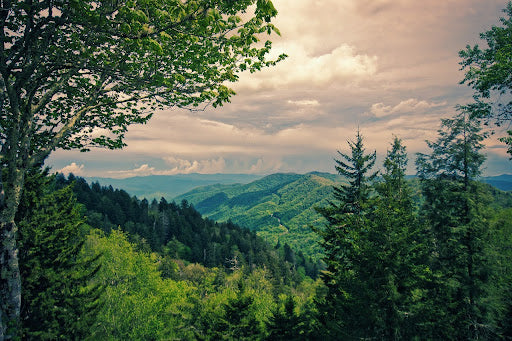From the hills and mountains in the highlands to the swamps and beaches in the lowlands, the southeast region offers one of the most diverse landscapes in the United States. It’s abundant in natural resources—from cotton and sugar cane to natural gas and minerals. With long summers and lots of hot and sunny days, this tropical region has become a popular spot for people to travel to. What’s more, this region has several national parks you can explore in your RV.
To help you plan your journey, here are five national parks in the southeast you can check off your bucket list in 2024. To get into the national parks, all visitors are required to have an entrance pass. You can also just get a day pass for each individual park.

5. Everglades National Park, FL
Everglades National Park includes 1.5-million acres of wetland and protects several endangered species, such as the manatee, American crocodile, and Florida panther. There are several ways to enjoy the park–from kayaking waterscapes to hiking for up-close views of the glades.
Know Before You Go
The park has three entrances in three different cities that are not connected: the Homestead Entrance/Ernest F. Coe Visitor Center, Miami Entrance/Shark Valley Visitor Center, and the Everglades City Entrance/Gulf Coast Visitor Center. If you choose to visit the park in the summer, get there early to avoid the crowds and heat. The best time to visit is between December and March since there is no humidity or bugs. In Florida, July to November is hurricane season. Lastly, be cautious of crocodiles and alligators while in the park. Within the park area, RVers have the option of staying at Flamingo Campground, which has electric hookups, or Long Pine Key Campground, which has no hookups.
Ways to Explore
Everglades National Park is an amazing place to spot everything from turtles to alligators. To get up close and personal with this landscape, check out the popular 0.8-mile Anhinga Trail to potentially spot wildlife or hike to the top of the observation tower on Shark Valley for a unique view of the glades. You can also take a historical tour to the HM69 Nike Missile Base from the Cold War, paddle a kayak through the Florida Bay, or cycle along Pineland Trail.

4. Ocmulgee Mounds National Historical Park, GA
If you have a passion for American history, then plan a trip to Ocmulgee Mounds National Historical Park in Georgia—a prehistoric American Indian Site. Dating all the way back to the Paleo-Indian Period, American Indian cultures hunted Ice Age mammals and built mounds here, which can still be seen in the park. If you’re ready to go back thousands of years in time, then here’s your guide to visiting this park.
Know Before You Go
The park prohibits climbing on mounds, flying kites, and swimming in the Ocmulgee River since there are alligators. In addition, picnicking is only allowed in designated picnic areas and dogs must be leashed and aren’t allowed in the visitor center unless they are a service dog. Be cautious of venomous snakes and alligators while visiting. Within the park area, RVers have the option of staying at Lake Tobesofkee in Macon, which has hookups.
Ways to Explore
To delve into this park’s past, explore over 2,000 artifacts in the visitor center’s museum, see seven historical mounds up close, or visit the reconstructed Earth Lodge with a floor that dates back to the year 1050. Those who love fresh air can take advantage of eight miles of hiking trails in the park, such as the popular 2.4-mile Bartram and River Loop Trail for some peace and quiet.

3. Shenandoah National Park, VA
Just 75 miles from Washington D.C., Shenandoah National Park is a beautiful spot for viewing waterfalls, wildflowers, and the Blue Ridge Mountains. The park includes over 200,000 acres of preserved land that provides a home for wildlife, such as the black bear and white-tailed deer. While here, take a scenic ride on the 105-mile Skyline Drive or hike part of the Appalachian Trail.
Know Before You Go
The busiest time to visit Shenandoah National Park is the summer and fall. If you plan on coming during this time, get there early to avoid the crowds. If you don’t want to sit in long lines to get into the park, enter at either the Rockfish or Swift Run entrance instead of the Front Royal or Thornton Gap entrance. Visitors with dogs must keep them on leash and it’s recommended that visitors always stay on trails for their own safety. Within the park area, RVers have the option of staying at Mathews Arm Campground, Big Meadows Campground, Loft Mountain Campground, or Lewis Mountain Campground, all of which have no hookups.
Ways to Explore
In addition to scenic views from Skyline Drive, park your RV to explore a local hiking trail and cascading waterfalls while in the park. Stony Man, the highest point on the Appalachian Trail, can be a great hike for families since it’s only 1.6-miles long. To get jaw-dropping views of Thornton Hollow and the surrounding mountains, check out the Thornton Hollow Overlook. For those who want to push a few more miles while in the park, Rose River Falls is a stunning waterfall that’s worth the four-mile trip.

2. Great Smoky Mountains National Park, NC and TN
With diverse plant and animal life, an ever-lasting morning fog, and historical buildings, it’s no wonder why Great Smoky Mountains National Park is America’s most visited national park. The park sits between North Carolina and Tennessee and is home to one of the country’s most ancient mountain ranges. With so much beauty and history, this national park is a must-add to your bucket list.
Know Before You Go
The best time to visit Great Smoky Mountains National Park is in the spring since flowers are blooming and humidity is low. Unlike other national parks, there is no entrance fee to get into the park. There are almost 2,000 bears within the park, so you should know how to handle bear situations before entering. RVers have the option of staying at Abrams Creek Campground, Balsam Mountain Campground, Big Creek Campground, Cades Cove Campground, Cataloochee Campground, Cosby Campground, Deep Creek Campground, Elkmont Campground, Look Rock Campground, or Smokemont Campground, all of which have no hookups.
Ways to Explore
While exploring this historical park, check out ancient and preserved buildings, such as churches, barns, and schools. This park is also home to gorgeous waterfalls, like Laurel Falls. If you’re up for a challenge, the 11-mile Alum Cave Trail to Mount LeConte is a popular adventure for visitors that features rocky trails and gorgeous mountain views. Clingsmans Dome Observation Tower is a steep path that crosses the Appalachian Trail and takes you to the park’s highest point. What’s more, you may spot some salamanders, black bears, and other wildlife while in the park.

1. Congaree National Park, SC
If the Carolinas are on your bucket list, don’t miss your chance to check out Congaree National Park. It’s home to some of the highest trees on the east coast—making it quite a special place in the southeast region. For thousands of years, Native Americans utilized the hardwood forest trees in this landscape for resources, which is why the park is named after the Congaree Indians. From swamplands to stunning trees, Congaree National Park is worth the trip.
Know Before You Go
Spring and fall are the best times to visit Congaree National Park since the temperatures are comfortable and the crowds are minimal. There are no RV sites within the park area, but RVers do have the option of staying nearby at Sweetwater Lake Campground, which has hookups.
Ways to Explore
From hiking to fishing to paddling, there are several ways to enjoy this national park. Hikers will love the 2.3-mile Boardwalk Loop Trail that is lined with plants, flowers, and tall trees. Fishers and paddlers can get out on the calming Cedar Creek Canoe Trail, which moves 15 miles through the Congaree Wilderness. While here, you may even spot some turtles, otters, owls, and alligators.
With there being so many national parks in the southeast, it’s hard to say which are the best. The diverse landscape of this region allows each national park in the southeast to offer something special. Whether you prefer exploring southern mountains or scenic swamplands, there is surely a national park on this list that you’ll enjoy driving through in your RV. For more warm-weather destinations, we have a guide on warm places to escape to in your RV during winter as well.
See you on the road!






Share:
5 Best National Parks for Beach Bums
Your Guide to Exploring the Dakotas in Your RV